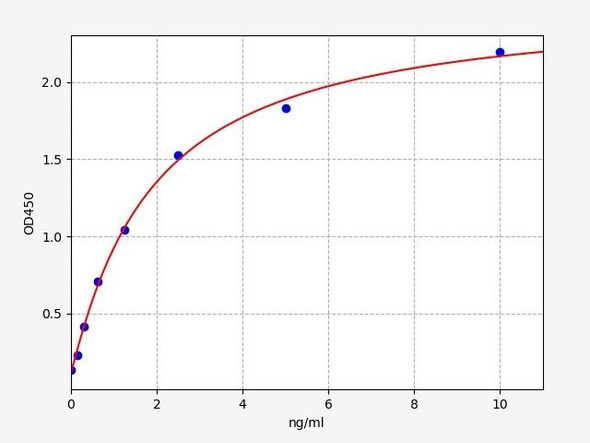Description
| Product Name: | Human VNN1 Recombinant Protein |
| Product Code: | RPPB5126 |
| Size: | 10µg |
| Species: | Human |
| Target: | VNN1 |
| Synonyms: | Vanin 1, Vascular Non-Inflammatory Molecule 1, Pantetheine Hydrolase, EC 3.5.1.92, Vanin-1, HDLCQ8, Tiff66, Pantetheinase, Vannin 1, EC 3.5.1, VNN1. |
| Source: | Escherichia Coli |
| Physical Appearance: | Filtered White lyophilized (freeze-dried) powder. |
| Formulation: | VNN1 was filtered (0.4 �m) and lyophilized in 20mM Tris buffer, 50mM NaCl and 0.1% amisoft CS-22, pH 7.5. |
| Solubility: | It is recommended to add 200�l of deionized water to prepare a working stock solution of approximately 0.5mg/ml and let the lyophilized pellet dissolve completely. VNN1 is not sterile! Please filter the product by an appropriate sterile filter before using it in the cell culture. |
| Stability: | Store lyophilized protein at -20°C. Aliquot the product after reconstitution to avoid repeated freezing/thawing cycles. Reconstituted protein can be stored at 4°C for a limited period of time; it does not show any change after two weeks at 4°C. |
| Purity: | Greater than 95.0% as determined by SDS-PAGE. |
| Amino Acid Sequence: | MKHHHHHHASQDTFTAAVYE HAAILPNATL TPVSREEALA LMNRNLDILE GAITSAADQG AHIIVTPEDA IYGWNFNRDS LYPYLEDIPD PEVNWIPCNN RNRFGQTPVQ ERLSCLAKNN SIYVVANIGD KKPCDTSDPQ CPPDGRYQYN TDVVFDSQGK LVARYHKQNL FMGENQFNVP KEPEIVTFNT TFGSFGIFTC FDILFHDPAV TLVKDFHVDT IVFPTAWMNV LPHLSAVEFH SAWAMGMRVN FLASNIHYPS KKMTGSGIYA PNSSRAFHYD MKTEEGKLLL SQLDSHPSHS AVVNWTSYAS SIEALSSGNK EFKGTVFFDE FTFVKLTGVA GNYTVCQKDL CCHLSYKMSE NIPNEVYALG AFDGLHTVEG RYYLQICTLL KCKTTNLNTC GDSAETASTR FEMFSLSGTF GTQYVFPEVL LSENQLAPGE FQVSTDGRLF SLKPTSGPVL TVTLFGRLYE KDWASNASSG |
Vanin 1 (VNN1) belongs to the vanin family of proteins, which share extensive sequence similarity with each other, and also with biotinidase. This family includes secreted and membrane-associated proteins, a few of which have been described to participate in hematopoietic cell trafficking. No biotinidase activity has been established for any of the vanin proteins; nevertheless, they possess pantetheinase activity, which may have a role in oxidative-stress response. VNN1 protein, like its mouse homolog, is probably a GPI-anchored cell surface molecule. The mouse VNN1 protein is expressed by the perivascular thymic stromal cells and regulates migration of T-cell progenitors to the thymus. VNN1 is an amidohydrolase which hydrolyzes specifically one of the carboamide linkages in D-pantetheine thus recycling pantothenic acid (vitamin B5).
VNN1 Human Recombinant produced in E.Coli is a single, non-glycosylated, polypeptide chain (Gln22-Gly491) containing 480 amino acids including a 10 aa His tag at N-terminus. The total calculated molecular mass is 53.5kDa.
| UniProt Protein Function: | VNN1: Amidohydrolase that hydrolyzes specifically one of the carboamide linkages in D-pantetheine thus recycling pantothenic acid (vitamin B5) and releasing cysteamine. Belongs to the CN hydrolase family. BTD/VNN subfamily. |
| UniProt Protein Details: | Protein type:Motility/polarity/chemotaxis; EC 3.5.1.92; Hydrolase; Membrane protein, integral; Cofactor and Vitamin Metabolism - pantothenate and CoA biosynthesis; Cell adhesion; Membrane protein, GPI anchor Chromosomal Location of Human Ortholog: 6q23-q24 Cellular Component: integral to membrane; plasma membrane Molecular Function:pantetheine hydrolase activity Biological Process: positive regulation of T cell differentiation in the thymus; chronic inflammatory response; cell-cell adhesion; pantothenate metabolic process; innate immune response; response to oxidative stress; cell motility; inflammatory response; acute inflammatory response |
| NCBI Summary: | This gene encodes a member of the vanin family of proteins, which share extensive sequence similarity with each other, and also with biotinidase. The family includes secreted and membrane-associated proteins, a few of which have been reported to participate in hematopoietic cell trafficking. No biotinidase activity has been demonstrated for any of the vanin proteins, however, they possess pantetheinase activity, which may play a role in oxidative-stress response. This protein, like its mouse homolog, is likely a GPI-anchored cell surface molecule. The mouse protein is expressed by the perivascular thymic stromal cells and regulates migration of T-cell progenitors to the thymus. This gene lies in close proximity to, and in the same transcriptional orientation as, two other vanin genes on chromosome 6q23-q24. [provided by RefSeq, Feb 2009] |
| UniProt Code: | O95497 |
| NCBI GenInfo Identifier: | 76803830 |
| NCBI Gene ID: | 8876 |
| NCBI Accession: | O95497.2 |
| UniProt Related Accession: | O95497 |
| Molecular Weight: | |
| NCBI Full Name: | Pantetheinase |
| NCBI Synonym Full Names: | vanin 1 |
| NCBI Official Symbol: | VNN1�� |
| NCBI Official Synonym Symbols: | HDLCQ8; Tiff66�� |
| NCBI Protein Information: | pantetheinase |
| UniProt Protein Name: | Pantetheinase |
| UniProt Synonym Protein Names: | Pantetheine hydrolase; Tiff66; Vascular non-inflammatory molecule 1; Vanin-1 |
| Protein Family: | Pantetheinase |
| UniProt Gene Name: | VNN1�� |
| UniProt Entry Name: | VNN1_HUMAN |









